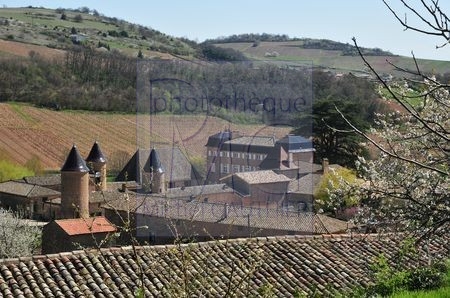Chasselas, Saône-et-Loire
Chasselas is a commune in the Bourgogne region in the department of Saône -et -Loire. Administratively, the church is assigned to the Canton of La Chapelle -de- Guinchay and the Mâcon district.
- 4.1 Castle
Geography
The small village with 179 inhabitants (as of 1 January 2011) is located in Mâcon about 14 km southwest of Macon; it is the rear-end village in the Vallée de l' Arlois whose source area is located at least 400 meters.
The site offers in a southerly direction a eindruchsvollen overlooking the plain of Bresse, the Mont Blanc and the mountains of the Monts du Lyonnais.
History
Remains to be seen, especially in the forested area between Chasselas and the neighboring community Vergisson, testify that Chasselas the Gallo -Roman period was a relay on the Roman road from Lutezia after Lugdunum.
Demographics
Viniculture
Today it is almost certain that the place is named after the Chasselas vine of the same. Chasselas is both in France and in French-speaking - as well as in German-speaking Switzerland the only common term for grape variety Chasselas.
The Vicomte d' Auban, a French diplomat is said to have brought the Chasselas grape in 1523 from the Turkish Konstantin Opel to Burgundy. In the village of Chasselas Chasselas should then have been first cultivated in France.
Chasselas is one of the seven churches (the other six: Chânes, Davayé, Leynes, Prissé, Saint- Vérand and Solutrense Pouilly ), which produces the Classified Growth Saint- Véran.
Attractions
- Romanesque church build in the 12th century. Unusually, the bell tower with a square base - similar to the priory of Cluny - was grafted onto the roof in the middle. The four corners of the tower are decorated with wolf heads.
- Intact houses from the 15th and 16th centuries.
Castle
The fortified castle Château de Chasselas (since 1979 listed building) dates back to the 14th century and stands on the edge of a small hill in the middle of the vineyards. The ramparts form a large rectangular courtyard. At three corners projecting each a tower with a circular ground plan up. The three towers ( originally there were four) have distinctive pointed cone roofs covered with glazed tiles. The cultivation in the east is from the 16th, the residential building to the south dating from the 18th century.
In the early 13th century the family of Chasselas took control of the lands. From 1485 to 1591 the castle belonged to the family You Roux, the last heiress Judith du Roux, Lady of Chasselas and Pouilly, first married the Huguenot Lyonnet Challes, who was beheaded for banditry in Trévoux, and then Philibert de Bellecombe, Lord of Vinzelles. 1629 Judith's husband died and her son Philibert Jacques de Bellecombe of the plague. 1654 Heritage Jacques de Bellecombe was murdered. 1706 the family sold the estate Bellecombe and the poorly preserved castle to Thomas Paissaud, tax collector of Mâcon. After the bankruptcy of the latter, the castle fell to Laurent Fayard, of it - also indebted - 1756 Laurent de La Fond de La resold role. As well as this ran into financial difficulties, the creditor Étienne d' Cellard Estours took over the estate - the coat of arms of the Lord shall be composed of three towers. His son could not prevent the castle plundered before the French Revolution in March 1789 and a tower was destroyed.
In 1971, took over Mr. Reme and his wife, nee Cuverville, the castle. The two wore the elaborate restoration of the building; their Oriflamme is immortalized on one of the towers. Today, the castle and its affiliates vineyards with a cultivated area of eight hectares is used by the agricultural cooperative of Chasselas. The Association also maintains a wine cellar and the tasting of their products is quite possible annually.

_1.JPG/270px-Chasselas_(Sa%2525C3%2525B4ne-et-Loire)_1.JPG)







